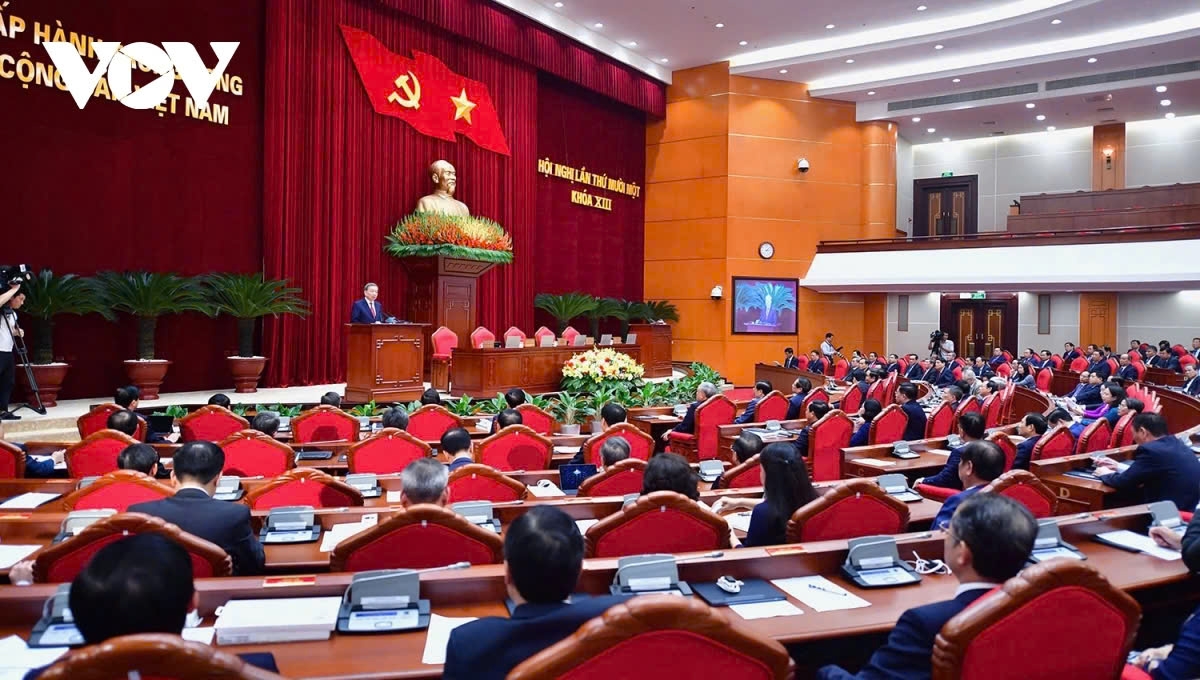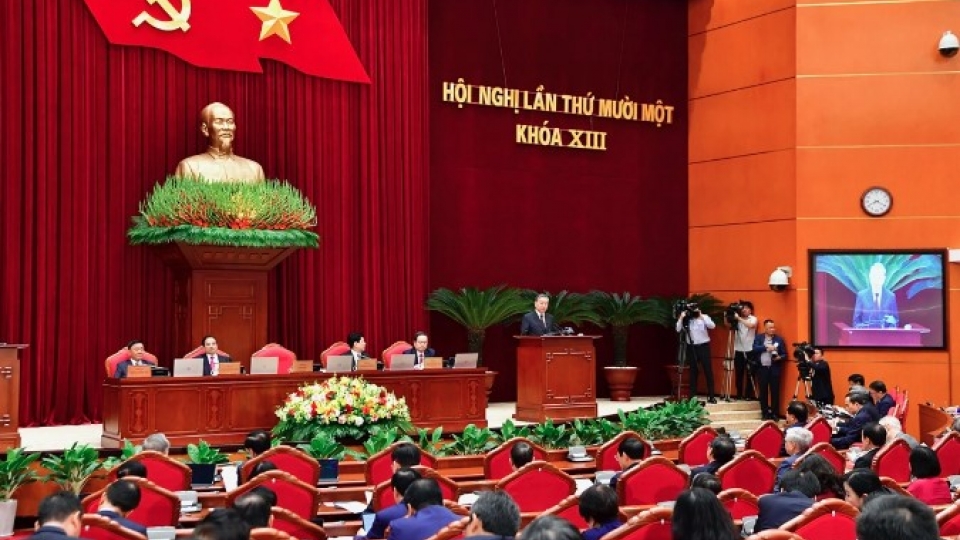Elite Party officials approve historic decisions to move Vietnam forward
VOV.VN - The Party Central Committee adopted a resolution at the closing ceremony of its three-day 11th plenum in Hanoi on April 12, outlining historic decisions to drive Vietnam forward into a new development phase.
Apparatus restructuring

The Party Central Committee reached a high consensus on proposals, reports, and schemes regarding continued restructuring of the political system’s apparatus, administrative units, and the two-tier local government model.
Key Party members held this is a historic strategic decision aimed at rapid, stable, and sustainable national development. The goal is to streamline governance, transition from passive management to active public service, and create a system capable of implementing Party guidelines and policies effectively.
Accordingly, Vietnam will apply the two-tier local government model (provincial and commune levels). To do this, it will reduce the number of provinces and cities from 63 at present to 34, eliminate the district level (after constitutional amendments) and at the same time reduce 60-70% of current commune-level units nationwide.
The provincial level will now both implement central policies and enact local policies, while the commune level will be strengthened with more authority and autonomy.
After the restructuring, local governments must be streamlined, efficient, and closer to the people. They must meet the requirements of modern social governance and be capable of achieving rapid and sustainable growth goals. The new structure should create a stronger foundation and momentum for fulfilling key national tasks such as defence, security, and foreign affairs.
In addition, it should serve as a driving force for economic development, with a focus on promoting the private sector, accelerating scientific and technological advancement, and fostering innovation. Most importantly, it should ensure continuous improvement in the material and spiritual well-being of the people.
The key Party members also gave opinions on the restructuring of the Vietnam Fatherland Front and socio-political organisations, which they said aim for compactness, non-overlapping responsibilities, and strong local presence. These organisations must act as the ‘extended arm’ of the Party, reaching every household and citizen.
They agreed in principle to continue the streamlining and restructuring of the organisational system of the People’s Courts and the People's Procuracies, by terminating the operations of the High-level People's Courts and Procuracies, as well as those at the district level. A three-tier organisational system for the People’s Courts and the People's Procuracies will be established, consisting of the Supreme People’s Court and the Supreme People’s Procuracy; the Provincial- and Municipal-level People’s Courts and Procuracies and regional-level ones.
Preparations for Party congress

The Party members held that draft documents for the coming 14th National Party Congress are now 30-35% shorter, yet more concise, action-oriented, and comprehensive. They reached consensus on the main goal of the Congress that is to decide strategic issues ensuring stability, development, and improved living standards.
However, sub-committees were requested to continue reviewing the feedback from the Party Central Committee, and to comprehensively supplement information on the objective difficulties and challenges, the long-standing shortcomings and limitations that have persisted across multiple terms without resolution, as well as the tasks and solutions adapted to the new context, new opportunities and challenges.
At the same time, Party committees were required, during the process of preparing and organising their congresses, to focus on thoroughly discussing the tasks and solutions in order to continue contributing to the finalisation of the documents for the 14th National Party Congress and for their respective local congresses.
Accordingly, key tasks are to foster high-quality, rapid, and sustainable development driven by science, innovation, and digital transformation; emphasize self-reliant and proactive growth; push for a new growth model, with private sector as a key driver of the economy; and build a modern education system.
The key Party members also reached consensus on personnel orientation and revision of regulations on Party discipline and oversight; and clear guidance on preparation for Party congresses at all levels, especially in newly merged provinces and communes. They emphasized that performance and work capacity must be the top criteria in personnel appointments.
Immediate actions required
Right after the plenum, the Party Central Committee will direct all Party organisations, government bodies, and localities to immediately communicate and guide public opinion to ensure unity and consensus; rapidly implement the restructuring plans approved; and carefully manage personnel transitions to avoid talent loss and ensure fair treatment of affected individuals.
All Party organisations, government bodies, and localities were required to secure proper management and allocation of public assets and facilities to prevent loss or corruption; maintain uninterrupted operations before, during, and after restructuring; and organise local Party congresses after administrative mergers, with substantive, not mechanical, consolidation of documents.
With regard to personnel planning, Party General Secretary To Lam, in his closing speech, reminded that comp0etent authorities will issue specific criteria and guidelines, with top priority to be given to job performance and then other qualifications.
He said the Politburo and Secretariat will soon convene a national conference for officials to ensure unified understanding and action. They will issue a resolution on legal reform and another resolution on private sector development alongside Resolution No. 57 on breakthroughs in the development of science, technology, innovation, and national digital transformation, and Resolution No. 59 on international integration in the new context, aiming to achieve the GDP growth target of 8% or higher in 2025, laying the foundation for sustained double-digit growth in the following years.
The goal is to successfully achieve the milestone of becoming a modern industrialized country with upper-middle-income status by 2030, and a high-income developed country by 2045, he stressed.
He expressed his belief that, with unity, resilience, and wise leadership, the entire Party, people, and army will overcome all challenges and achieve the strategic goals.




